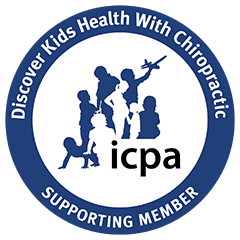Did you know that a newborn baby will spend 16-17 hours a day sleeping? According to the American Academy of Pediatrics, that should be on their back to reduce the risk of Sudden Infant Death Syndrome or SIDS. However, as a result, many infants are developing flat spots on the back of their heads.
While parents may not like how it looks, the bigger concern here is not cosmetic but the potential compromised neurological function from the cranial distortions. But what are parents to do? They can’t hold their baby every waking moment…or can they?
Why to Wear Your Baby
According to Dr. William Sears, the pediatrician that coined the phrase “attachment parenting,” being in this position for most of their waking hours has been shown to be beneficial for neural development, gastrointestinal and respiratory health.
Some additional benefits include:
- Improved Learning Environment: Babies that are worn while awake also spend much more time in a quiet and alert state which is ideal for learning. Since they are feeling safe and secure they are more open to outside stimuli and that is the world from your point of view
- Becoming Independent Earlier: They are also closer to people and can study facial expressions, so carried infants are more socialized and will typically learn to speak sooner and be more familiar with body language, becoming independent at an earlier age.
- Calmer Baby: Research has shown that babies who are carried cry 43% less than those who aren’t. When babies are carried both their primal and survival needs are being met. The parental rhythms (walking, heartbeat, etc.) have a balancing and soothing effect on the infant. Plus they can see, hear, smell, touch and even taste their primary caregiver making them calmer.
- Improved Vestibular System: The vestibular system is a collection of structures in the inner ear that provides the sense of balance and an awareness of right-side up or upside down. This system is actually one of the first to be developed in-utero and is part of the very first reflexes that can be tested in infants. The motion of the caregiver activates the vestibular system, which may improve the infant’s ability to absorb the sights and sounds of their environment. This may improve the development of their motor, cognitive and emotional skills later in life.
- Reduced Risk of “Flat Head Syndrome”: Due to the decreased amount of time spent on their backs, the risk of plagiocephaly or the above-mentioned “flat head syndrome” is greatly reduced.
Benefits of Baby Wearing for Mom
Baby wearing also has benefits for the mother. These include:
- Provides Closeness with Multitasking: When cooking, cleaning, running after a toddler, grocery shopping or performing any other typical parental task, wearing your baby allows for the baby’s continued security while making it possible for you to perform other functions.
- Increased Oxytocin Levels: This leads to a more intimate maternal bond, easier breastfeeding, and potentially lowering the incidence of postpartum depression.
- Protect Mom’s Back: Since the hormone Relaxin may stay in your body up to nine months following delivery, ease in carrying your baby and less lifting of car seats may decrease chances for postural or spinal misalignments that could cause discomfort.
How to Wear Your Baby
With the increase in information available, baby wearing has become more popular so there is a wide variety of slings and carriers available.
- Slings: Slings with rings can be used for newborns, older babies and toddlers. The sling is typically adjusted by running the tail fabric through the rings and then tightening or loosening it until the wearer feels comfortable. With a sling, the baby can be on the front, side or back.
- Pouch carriers: These are similar to slings but offer fewer options for adjustment and generally hold the baby in the front or back only.
- Long, tied wraps: These are 12 feet long and made of woven or knit fabric. The wearer wraps and ties the fabric around her and the baby to keep the infant secure.
- Backpack/Front Carriers: Since the design is more rigid in structure it doesn’t always offer options for baby positioning and are not flexible from one wearer to the next, but are a more common carrier option.
How to Choose a Carrier
When considering the purchase of a carrier, be sure to think about the following:
- Can the carrier be worn on the front, side and back?
- Can the baby be positioned chest-facing, upright, supine and with either their legs straight or bent comfortably?
- Can a sleeping baby be transferred to their crib or another caregiver without waking?
- Can the baby breastfeed discreetly and comfortably while in the carrier?
- Is the carrier large enough to be used for several months?
- Is it washable and how difficult is it to wash?
- Does the carrier evenly distribute the infant’s weight for the comfort of the wearer or will it cause stress or postural compensations to the wearer’s spine?
- Can the infant be shifted or repositioned easily, or will the wearer require assistance?
- When using the carrier are the wearer’s hands free or must they support the baby with one hand?
The Chiropractic Factor
Clearly, baby wearing is beneficial for both mom and baby, but you may still have questions, or you’ve only heard about this recently and need more information.
Since 2008, International Baby Wearing Week has been happening every October to help raise awareness. Some have expressed concerns about hip dysplasia; if this is your concern ask Dr. Elyssa for information. You may be concerned that the wraps will be too complicated; a quick search on YouTube will provide several tutorials including a very helpful one by Naturally Thrifty Mom.
To learn more about the benefits of chiropractic care and the benefits of making it part of your family’s wellness lifestyle click below to schedule a complimentary consultation with Dr. Elyssa today.



